Embracing the Cheongsam Style: A Timeless Elegance
The cheongsam style, also known as the qipao, is a traditional Chinese dress that has captivated the world with its unique blend of elegance and sophistication. Originating in the 1920s, this form-fitting garment has evolved over time, reflecting the changing dynamics of Chinese culture and fashion. Its allure lies not only in its aesthetic appeal but also in the cultural significance it carries. As we delve into mastering the cheongsam style, we explore its history, cultural nuances, and the modern interpretations that have kept it relevant in contemporary fashion.

The Historical Tapestry of the Cheongsam Style
The cheongsam style emerged during the Republic of China era as a symbol of modernity and femininity. As stated by renowned fashion historian Dr. Valerie Steele, “The qipao represents a fusion of traditional Chinese clothing with Western influences, particularly in its tailored fit and use of slits.” This garment was not only a fashion statement but also a political one, as it represented the new aspirations of Chinese women seeking to break free from the constraints of traditional society.

Cultural Significance and Symbolism
The cheongsam style is more than just a dress; it is a cultural artifact rich with symbolism. Each element, from the high collar to the side slits, carries a specific meaning. For instance, the collar, often referred to as the Mandarin collar, symbolizes dignity and respect. The side slits, a distinctive feature, are said to represent the balance between tradition and modernity. As quoted by a well-known cultural commentator, “The qipao is a canvas of Chinese culture, where each thread tells a story of our heritage.”

Adapting the Cheongsam Style for the Modern World
In the contemporary fashion landscape, the cheongsam style has been reimagined to cater to a global audience. Designers have experimented with various fabrics, patterns, and cuts to create a fusion of the traditional and the contemporary. This has led to a resurgence in the popularity of the qipao, as seen in international fashion weeks and red carpet events. The adaptability of the cheongsam style is a testament to its timeless appeal and the enduring influence of Chinese culture on global fashion.

Mastering the Art of Wearing the Cheongsam Style
To truly master the cheongsam style, one must understand its fit, fabric, and the art of accessorizing. A well-tailored qipao accentuates the natural curves of the body, while the choice of fabric can range from silk to brocade, each with its own unique texture and sheen. Accessories such as jade jewelry and traditional Chinese shoes can enhance the overall look, creating a harmonious blend of elegance and cultural pride. As a fashion icon once said, “The qipao is not just something you wear; it’s an expression of who you are.”

Conclusion: The Cheongsam Style as a Cultural Legacy
The cheongsam style is more than a fashion trend; it is a cultural legacy that continues to inspire and influence. As we embrace this timeless elegance, we carry forward the rich history and cultural significance of the qipao. Whether worn at a traditional Chinese event or as a statement piece in a modern wardrobe, the cheongsam style stands as a symbol of beauty, grace, and heritage.






